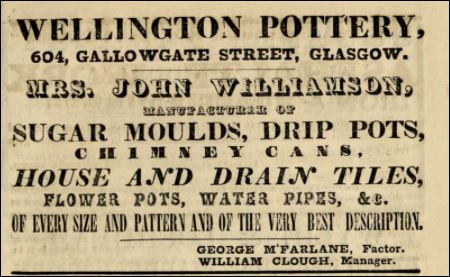Wellington Sugar Mould and Tile Works, Gallowgate, Glasgow.
1797 – In 1797 the Wellington claypits were opened by the Williamsons who were joined latterly by Adam Cubie.
1825 – Adam Cubie, Brick and Tile Maker, Gallowgate, Glasgow.
17/01/1845 – Glasgow Herald – A field of clay to be let immediately adjoining Wellington Pottery, Gallowgate Street, particularly well adapted for brickmaking, with sufficient spread ground for one or two tables. The clay is of excellent quality and the field of easy access, being bounded on roads on all sides. For particulars apply to Mr Williamson on the ground or at Tontine Back Buildings. Glasgow 16/01/1845.
18/05/1849 – Glasgow Herald – Sugar Mould Pottery and Tile Work to let. To be let with immediate possession. These well known works (the first of the kind established in Scotland), situated in Gallowgate Street of Glasgow, known as the Wellington Pottery, with the extensive field of valuable and fine clay adjoining, as lately occupied by the deceased, Mr John Williamson, the successor to the late Adam Cubie, Esq. There are five throwing wheels, with all the necessary workshops, stoves, kilns, clay mills, steam engine, and other machinery, and conveniences, suitable for carrying on, upon a large scale, the manufacture of sugar moulds, water pipes, chimney cans, garden pots, &c. There are also extensive sheds, and other accommodation, for making drain and roof tiles, of all descriptions to a large extent, and arrangements may be made for allowing a tenant to carry on the manufacture of brown ware. The field of clay attached to the works is abundant, of a very superior description, and suitable for all the above purposes. From their close vicinity to the centre of Glasgow, the facilities of shipment, and other conveniences, these works are admirably adapted for carrying on the business in all its branches. And as the whole are in complete working order, and have been kept in operation since the death of the late proprietor; and as the tenant will obtain the goodwill of the business, which is extensive and respectable, the opening is important and eligible. There are also, adjoining, dwelling-houses, suitable for a manager and workmen, which may either be let along with the pottery or separately. Apply to Mr Grainger, at the Works: or to A. & A. MacGeorge, Writers, 21 St. Vincent Place, Glasgow.
Below – 1852 – Wellington Pottery, 604 Gallowgate Street, Glasgow. Mrs John Williamson. Land drain tiles are also manufactured.

Below – A fragment found in a field near to Errol Station, Perth and Kinross by Michael Gillies – ‘Wellington Pottery Glasgow”



